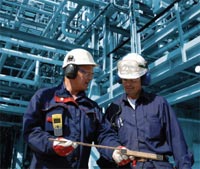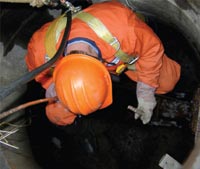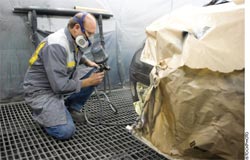
May 2008
- Use Your Data to Track Dangerous Behaviors
- Getting Acquainted with Confined Spaces
- H2S: The Silent Killer
- Looking into Increased Workplace Use of PAPRs
Click here to subscribe.
Cover Story

By Dave D. Wagner
The writing of this article follows on the heels of a meeting between the author and the chief deputy attorney general of the Commonwealth of Pennsylvania. The purpose of that meeting was to investigate and discuss the circumstances of a fatal Pennsylvania mining accident.
Features
By Hamed Khoshniat
On Jan. 16, 2002, two workers were killed and eight others were injured when they inhaled hydrogen sulfide gas leaked from an underground process sewer at the Georgia-Pacific Naheola mill in Pennington, Ala. Among the injured were workers who attempted to assist their colleagues from the deadly cloud. The gas was the product of a sudden, uncontrolled chemical reaction taking place in the sewer as the men worked above.
By Jerry Laws
Working a summer job many years ago on a crew of a county road repair department was my first full-time outdoor employment. Flagging for our paving machines and dump trucks that first day was a brutal education, but not because of the pace, the dust, the heat, or the toil. It was rough because I hadn’t known to bring my own jug of water. On Day Two and every work day thereafter, I was much better prepared.

By William Ball
With somewhere in the neighborhood of 10 million people employed, construction is one of the largest industries in the United States. That’s a lot of people to send home safe every day. Construction work sites present a number of potential safety hazards; employers, with increased awareness, are emphasizing safe work habits to reduce injuries.
By Gary Burris
It was bound to happen. Medical professionals warned about it more than 50 years ago when a surprisingly effective tool for fighting infections first entered into broad use in the 1950s. If we step back a bit more to 1939, when two European scientists used penicillin for the first time on a human patient, it becomes obvious why antibiotics have been so heavily prescribed to fight infections.
By Cristine Z. Fargo
It is hard to argue against the importance of the need for eyewashes and showers in the workplace, given the reported injuries to and incident statistics of workers who require medical treatment of some kind. Take eye injuries, for example—there are 800,000 reported eye injuries in the American workforce each year, many of which are caused by exposure to chemical hazards.
By Marc Barrera, Ronnie Rittenberry
Two safety tradeshows highlighted May and early June.
First up was the New York Incentive Rewards & Recognition Show, which took place May 7-8. One of this show's biggest incentives each year is its location; another is the chance to experience an all-in-one combination of exhibits, on-floor Power Sessions, and paid seminars focused on the show's theme, "Brands Powering People, People Powering Brands."
Then, returning to the Mandalay Bay Convention Center in Las Vegas for the first time since 2005, the National Fire Protection Association's annual World Safety Conference & Exposition will be held June 2-5, 2008, and promises to be the event's largest outing ever.
By Deborah Read
There’s a battle going on among professionals conducting office ergonomic evaluations, and you may not even be aware of it. Often, one of the hardest things for a professional is to change the way you do things—to change what you recommend to your clients. But this is exactly what we must do when we learn about research with practical applications.

By Don Groover, CIH, CSP, Jim Spigener
As the business landscape continues to change, safety professionals are faced with rethinking their traditional role. Staying relevant as the organization changes means learning how to leverage your knowledge, skills, and experience in new ways. This article, the second in a series on the changing role of the safety professional, presents the case for transitioning from technical expert to change agent and outlines the core competencies of this new role.
By Phillip G. Retallick
The Occupational Safety & Health Administration, through its Voluntary Protection Programs (VPP), sets high standards for companies. The challenge, and the reward, is to have safe working environments that not only meet government standards, but also exceed them to the point that your company’s safety program can be self-sustaining and become a model for your industry.

By William D. Hayes
The U.S. Environmental Protection Agency has released its final rule on emissions from auto refinishing operations. As a result, shops should expect to ramp up the time they spend on recordkeeping and training. The rule affects “area sources” of emissions; that is, those operations whose potential emissions are less than 10 tons a year of a single hazardous air pollutant or 25 tons per year of a combination of pollutants.
By Linda J. Sherrard
What can stop a speeding bullet or bomb fragments, repel fire, and protect the wearer from caustic or toxic substances and even the deadliest of pathogens? Personal Protective Apparel (PPA) can. To me, it is a superhero of safety!
Departments
By Robert Pater
Senior managers have become increasingly aware of Safety’s potential returns, well beyond loss reduction. And Safety culture is an especially hot topic among leaders who sense something is missing— that performance could be better.
By Jerry Laws
Hearing U.S. Chemical Safety and Hazard Investigation Board member William Wark’s Feb. 28 speech at the ISNetworld users group conference in Dallas confirmed my fear that we aren’t prepared for serious chemical leaks. By “we” I mean the public, but Wark also meant the employees who are shipping these materials and processing them.

By Linda J. Sherrard
Managing a safety program can be a struggle on the good days. All too often, managers and supervisors want to ensure the program is known as "your safety program" rather than the company's or department's safety program. That "hands off" approach will cause many elements of the goals and initiatives to stall quickly, and it sets up a method for blame to begin when things fall by the wayside.